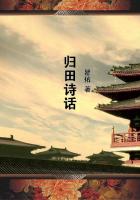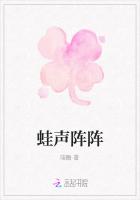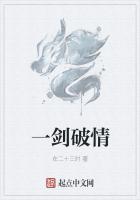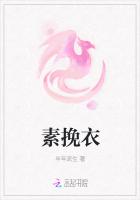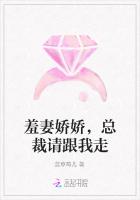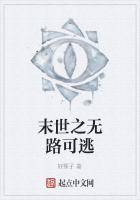Usages of the same sort are reported from Wales. Thus in North Pembrokeshire a tuft of the last corn cut, from six to twelve inches long, is plaited and goes by the name of the Hag (wrach); and quaint old customs used to be practised with it within the memory of many persons still alive. Great was the excitement among the reapers when the last patch of standing corn was reached. All in turn threw their sickles at it, and the one who succeeded in cutting it received a jug of home-brewed ale. The Hag (wrach) was then hurriedly made and taken to a neighbouring farm, where the reapers were still busy at their work. This was generally done by the ploughman; but he had to be very careful not to be observed by his neighbours, for if they saw him coming and had the least suspicion of his errand they would soon make him retrace his steps. Creeping stealthily up behind a fence he waited till the foreman of his neighbour's reapers was just opposite him and within easy reach. Then he suddenly threw the Hag over the fence and, if possible, upon the foreman's sickle. On that he took to his heels and made off as fast as he could run, and he was a lucky man if he escaped without being caught or cut by the flying sickles which the infuriated reapers hurled after him. In other cases the Hag was brought home to the farmhouse by one of the reapers. He did his best to bring it home dry and without being observed; but he was apt to be roughly handled by the people of the house, if they suspected his errand. Sometimes they stripped him of most of his clothes, sometimes they would drench him with water which had been carefully stored in buckets and pans for the purpose. If, however, he succeeded in bringing the Hag in dry and unobserved, the master of the house had to pay him a small fine; or sometimes a jug of beer from the cask next to the wall, which seems to have commonly held the best beer, would be demanded by the bearer. The Hag was then carefully hung on a nail in the hall or elsewhere and kept there all the year. The custom of bringing in the Hag (wrach) into the house and hanging it up still exists in some farms of North Pembrokeshire, but the ancient ceremonies which have just been described are now discontinued.
In County Antrim, down to some years ago, when the sickle was finally expelled by the reaping machine, the few stalks of corn left standing last on the field were plaited together; then the reapers, blindfolded, threw their sickles at the plaited corn, and whoever happened to cut it through took it home with him and put it over his door. This bunch of corn was called the Carleyprobably the same word as Carlin.
Similar customs are observed by Slavonic peoples. Thus in Poland the last sheaf is commonly called the Baba, that is, the Old Woman. In the last sheaf, it is said, sits the Baba. The sheaf itself is also called the Baba, and is sometimes composed of twelve smaller sheaves lashed together. In some parts of Bohemia the Baba, made out of the last sheaf, has the figure of a woman with a great straw hat. It is carried home on the last harvest-waggon and delivered, along with a garland, to the farmer by two girls. In binding the sheaves the women strive not to be last, for she who binds the last sheaf will have a child next year. Sometimes the harvesters call out to the woman who binds the last sheaf, She has the Baba, or She is the Baba. In the district of Cracow, when a man binds the last sheaf, they say, The Grandfather is sitting in it; when a woman binds it, they say, The Baba is sitting in it, and the woman herself is wrapt up in the sheaf, so that only her head projects out of it. Thus encased in the sheaf, she is carried on the last harvest-waggon to the house, where she is drenched with water by the whole family. She remains in the sheaf till the dance is over, and for a year she retains the name of Baba.
In Lithuania the name for the last sheaf is Boba (Old Woman), answering to the Polish name Baba. The Boba is said to sit in the corn which is left standing last. The person who binds the last sheaf or digs the last potato is the subject of much banter, and receives and long retains the name of the Old Rye-woman or the Old Potato-woman. The last sheafthe Bobais made into the form of a woman, carried solemnly through the village on the last harvest-waggon, and drenched with water at the farmer's house; then every one dances with it.
In Russia also the last sheaf is often shaped and dressed as a woman, and carried with dance and song to the farmhouse. Out of the last sheaf the Bulgarians make a doll which they call the Corn-queen or Corn-mother; it is dressed in a woman's shirt, carried round the village, and then thrown into the river in order to secure plenty of rain and dew for the next year's crop.
Or it is burned and the ashes strew on the fields, doubtless to fertilise them. The name Queen, as applied to the last sheaf, has its analogies in Central and Northern Europe. Thus, in the Salzburg district of Austria, at the end of the harvest a great procession takes place, in which a Queen of the Corn-ears (?hrenk?nigin) is drawn along in a little carriage by young fellows. The custom of the Harvest Queen appears to have been common in England. Milton must have been familiar with it, for in Paradise Lost he says:
Adam the while Waiting desirous her return, had wove Of choicest flow'rs a garland to adorn Her tresses, and her rural labours crown, As reapers oft are wont their harvest-queen.

